Main findings: further education and skills inspections and outcomes, as at 29 February 2020
Updated 21 September 2020
Applies to England
This is the main findings report for the further education and skills inspections and outcomes as at 29 February 2020 as at 31 March 2020 release. The following are also available:
- underlying data
- methodology
- pre-release access list
Introduction
This release contains:
- provisional data for the most recent inspections and outcomes on 29 February 2020
- provisional data for inspections and monitoring visits carried out between 1 September 2019 and 29 February 2020
- revised data for inspections and monitoring visits carried out between 1 September 2018 and 31 August 2019
We carried out inspections from 1 September 2019 under the education inspection framework (EIF). This replaced the common inspection framework, which was in effect from 1 September 2015 to 31 August 2019. This is the first official statistics release relating to inspections of further education and skills providers under the EIF.
Impact of coronavirus (COVID-19) on this release
All routine inspections and the publication of inspection reports were suspended in March 2020 due to COVID-19. The publication of reports has now restarted. However, there are some inspections excluded from this release as the reports were not published by the cut-off date of 31 March 2020. The suspension has had a minimal effect on the overall grades or messages in this publication.
The number of further education and skills providers has stabilised this reporting year. This marks a break in the trend seen over the past 2 years, where there had been large increases in the number of providers we were required to inspect.
The proportion of providers not yet inspected or visited as at 29 February 2020 was 13%. This is similar to the proportion as at 31 August 2017, before the further education and skills provider base rapidly expanded (see Figure 1).
Between 1 September 2019 and 29 February 2020, the proportion of providers inspected and judged to be good or outstanding was 67%. This is 12 percentage points higher than in 2018/19, due largely to short inspections not being carried out last year. In 2018/19, we focussed on carrying out a large volume of new provider monitoring visits. As such, the year-on-year figures are not directly comparable.
Three quarters of providers that were judged to be making reasonable or significant progress across all themes at their new provider monitoring visit, and received their first inspection between 1 September 2019 and 29 February 2020, were judged good.
Of the 8 prisons and young offender institutions that were previously judged good, 5 declined to requires improvement and one declined to inadequate.
Figure 1: Further education and skills providers most recently receiving an inspection or new provider monitoring visit, over time
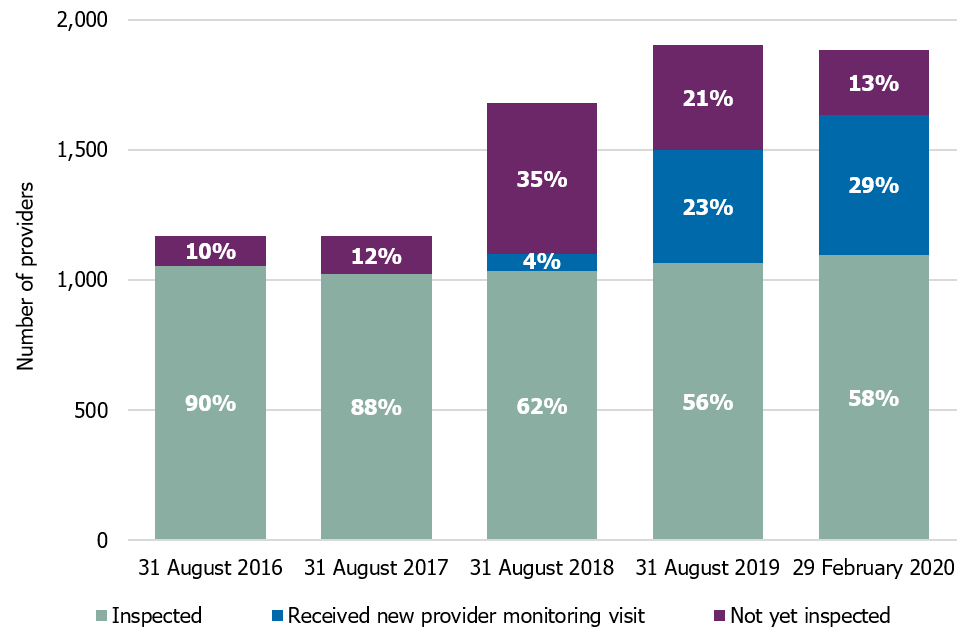
Percentages are rounded and may not add to 100.
Provider numbers, inspection volumes and outcomes
Provider numbers
The number of further education and skills providers has stabilised this reporting year.
On 29 February 2020, there were 1,884 further education and skills providers publicly funded and delivering education, training or apprenticeships, recorded on Ofsted’s systems; 19 fewer than on 31 August 2019. This marks a break in the trend seen over the past 2 years, when the number of providers had increased on 31 August 2017 and 31 August 2018 by 735 and 221 respectively. These large increases were mainly as a result of the apprenticeship funding reforms introduced in April 2017.
As at 29 February 2020, 1,636 (87%) of the 1,884 open and funded further education and skills providers had received a new provider monitoring visit or an inspection. This leaves 13% of the providers that we had not yet inspected or visited, which is similar to the levels seen before the apprenticeship funding reforms increased the provider base that we inspect. The percentage not yet inspected has reduced from 35% on 31 August 2018, to 13% as at 29 February 2020 (see Figure 1).
The number of general further education colleges that we report on continues to decline, as established colleges merge together to form new entities. Since 1 September 2019, there have been 3 mergers. One general further education college merged with a specialist designated institution and there was a merger between 2 general further education colleges and a sixth-form college. As at 29 February 2020, there were 168 general further education colleges recorded on Ofsted’s systems.
The number of 16 to 19 academies has increased by 5 since 1 September 2019, as 3 new 16 to 19 free schools opened and 2 sixth-form colleges converted to become 16 to 19 academies. As at 29 February 2020, there were 57 16 to 19 academies.
The number of sixth-form colleges that we report on continues to decline, as they merge with general further education colleges or academise. Since 1 September 2019, 1 sixth-form college has merged and 2 have academised. As at 29 February 2020, there were 51 sixth-form colleges recorded on Ofsted’s systems.
The number of independent learning providers (including employer providers) has declined by 11 to 1,181 as at 29 February 2020. Between 1 September 2019 and 29 February 2020, an additional 24 providers became publicly funded and started delivering education, training or apprenticeships, while 35 providers were no longer funded and had stopped delivering.
In-year monitoring visit volumes
There was a more equal balance of monitoring visits and inspections this reporting year compared with 2018/19.
A monitoring visit is an interim type of inspection that explores one or more specific themes. For further education and skills providers, monitoring visits can be broken down into 2 main categories:
- new provider monitoring visits
- other monitoring visits
We introduced new provider monitoring visits in 2018 for newly, directly and publicly funded providers at the request of the Department for Education. Inspectors make progress judgements by considering the impact of actions taken to develop the necessary knowledge, skills and behaviours of learners.
Other monitoring visits have been in place for more than 5 years. Inspectors assess the main areas for improvement identified in the inspection report for providers judged requires improvement or inadequate. We also use monitoring visits to assess providers with a safeguarding concern or, in the case of colleges that have merged, the relevant themes about the progress of the merged college, including from the most recent report(s) of the predecessor college(s).
Between 1 September 2019 and 29 February 2020, we carried out 213 monitoring visits, three quarters of which were new provider monitoring visits. The proportion of inspection activity represented by monitoring visits was 56%. This is a decrease of 12 percentage points compared with the last full reporting year and is due to us carrying out a higher number of short inspections.
Figure 2: Balance of inspections and monitoring visits, by reporting year

In-year new provider monitoring visit outcomes
Almost a quarter of apprenticeship providers were making insufficient progress in one or more areas at their new provider monitoring visit.
All but 3 of the 140 new provider monitoring visits to apprenticeship providers were to independent learning providers (including employer providers). The other 3 were to higher education institutions. Overall, 76% of providers were making at least reasonable progress across all themes they were assessed on. However, this leaves almost a quarter of providers making insufficient progress in one or more areas.
Table 1: Apprenticeship new provider monitoring visit outcomes, between 1 September 2019 and 29 February 2020
| Progress judgement | Insufficient progress | Reasonable progress | Significant progress |
|---|---|---|---|
| How much progress have leaders made in ensuring that the provider is meeting all the requirements of successful apprenticeship provision? | 33 | 97 | 10 |
| What progress have leaders and managers made in ensuring that apprentices benefit from high-quality training that leads to positive outcomes for apprentices? | 32 | 96 | 12 |
| How much progress have leaders and managers made in ensuring that effective safeguarding arrangements are in place? | 13 | 115 | 12 |
| What progress have leaders and managers made to ensure that learners benefit from high-quality adult education that prepares them well for their intended job role, career aims and/or personal goals?1 | 0 | 1 | 0 |
Table shows number of providers receiving each progress judgement.
1. This judgement was only made when a provider also offered adult education.
In addition, we carried out 6 new provider monitoring visits to newly directly funded providers delivering adult education, 4 to independent specialist colleges and one delivering 16 to 19 provision. Two providers delivering adult education provision received at least one insufficient progress judgement. All the other providers were judged to be making reasonable or significant progress across all themes.
There were also 10 safeguarding follow-up visits, after an insufficient judgement for safeguarding was made at a new provider monitoring visit. At these visits, 4 providers were still found to be making insufficient progress in safeguarding.
From new provider monitoring visit to first full inspection
Three quarters of providers that were judged to be making reasonable or significant progress across all themes at their new provider monitoring visit, were judged good at their first inspection between 1 September 2019 and 29 February 2020.
Between 1 September 2019 and 29 February 2020, we inspected 44 providers for the first time that had previously had a new provider monitoring visit. Three quarters of providers that were judged to be making reasonable or significant progress across all themes at their new provider monitoring visit, were judged good at their first inspection. The 4 providers judged insufficient across all themes went on to be judged inadequate. Whereas those providers with a mix of outcomes were more likely to be judged requires improvement at their full inspection.
Table 2: Overall effectiveness at first full inspection between 1 September 2019 and 29 February 2020, by previous new provider monitoring visit judgements
| New provider monitoring visit outcome | Outstanding | Good | Requires improvement | Inadequate |
|---|---|---|---|---|
| Reasonable or significant progress across all themes judged (28) | 0 | 21 | 6 | 1 |
| Mixed (12) | 0 | 2 | 9 | 1 |
| Insufficient progress in all themes judged (4) | 0 | 0 | 0 | 4 |
Number of inspections in brackets.
In-year inspection volumes and outcomes
The proportion of providers judged good or outstanding is 12 percentage points higher than in 2018/19, which is largely due to short inspections being included within the range of inspection activity this year.
Between 1 September 2019 and 29 February 2020, we inspected 169 further education and skills providers. This included 41 colleges, 85 independent learning providers (including employer providers), 25 community learning and skills providers, 9 16–19 academies, 8 independent specialist colleges and one higher education institution.
The 169 further education and skills inspections consisted of 123 full inspections and 46 short inspections (including those that converted to full inspections). The proportion of first inspections to providers is about the same as in 2018/19.
Figure 3: Proportion of full and short inspection activity, by inspection type and reporting year
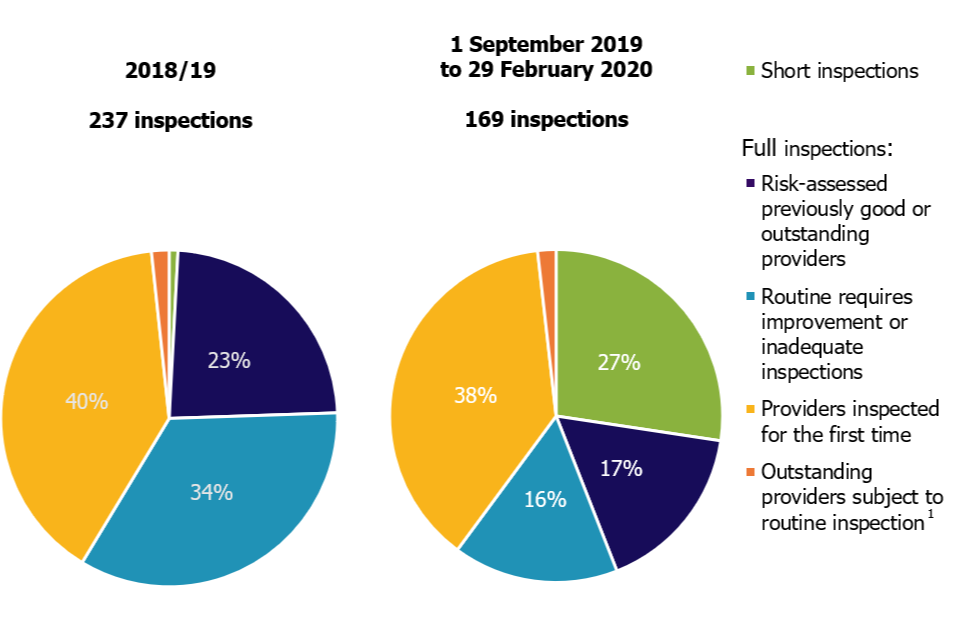
Percentages are rounded and may not add to 100. When the number of providers is small, percentages should be treated with caution.
1. The following provider types remain subject to routine inspection when judged outstanding: higher education institutions offering further education, local authority providers, independent specialist colleges and dance and drama colleges.
The first 3-year cycle of short inspections concluded on 31 August 2018. A policy change introduced on 1 September 2018 required providers previously judged good to be normally inspected within 5 years of their latest inspection. These changes led to only 2 short inspections being carried out in the last reporting year. From 1 September 2019 to 29 February 2020, we carried out 46 short inspections (including those that converted to full inspections).
Between 1 September 2019 and 29 February 2020, the proportion of providers inspected and judged good or outstanding was 67%. This is 12 percentage points higher than in 2018/19, which is largely due to short inspections being included within the range of inspection activity this year.
Figure 4: Further education and skills providers’ full and short inspection outcomes, by reporting year

Number of inspections in brackets.
Historically, around 90% of the providers that received a short inspection in any given year (including those that convert to a full inspection) remained good or improved to outstanding. Of the 46 short inspections (including those that converted to a full inspection) carried out this reporting year, 93% remained good or improved to outstanding.
Of the 169 providers inspected between 1 September 2019 and 29 February 2020, 166 had effective safeguarding arrangements in place for learners. Three providers were judged not to have effective safeguarding arrangements in place. One of these providers was previously judged requires improvement and had declined to inadequate. One was the first inspection of a merged sixth-form college. The other provider was inspected for the first time.
Most recent inspection outcomes
The proportion of providers judged good or outstanding at their most recent inspection has declined by one percentage point.
On 29 February 2020, 58% of the 1,884 further education and skills providers had received a full inspection. Of these, 80% were judged to be good or outstanding at their most recent inspection. This is a decrease of one percentage point compared with 31 August 2019.
The proportion of providers judged good or outstanding at their most recent inspection can be affected by:
- providers whose overall effectiveness grade improves or declines at inspection during the year
- new providers receiving their first overall effectiveness judgement
- Ofsted no longer reporting on providers because they have merged, ceased to be funded or have stopped delivering
Between 1 September 2019 and 29 February 2020, the group that had the biggest impact on the proportion judged good or outstanding was the new providers. There were almost twice as many providers receiving their first overall effectiveness judgement compared with those that we no longer reported on.
The proportion of newly inspected providers that were judged to be good or outstanding was 54%, which was lower than the overall proportion judged good or outstanding for all further education and skills providers as at 31 August 2019. This brought down the average for the whole provider base, reducing the proportion judged good or outstanding by one percentage point.
Figure 5: Overall effectiveness of further education and skills providers at their most recent inspection, on 29 February 2020
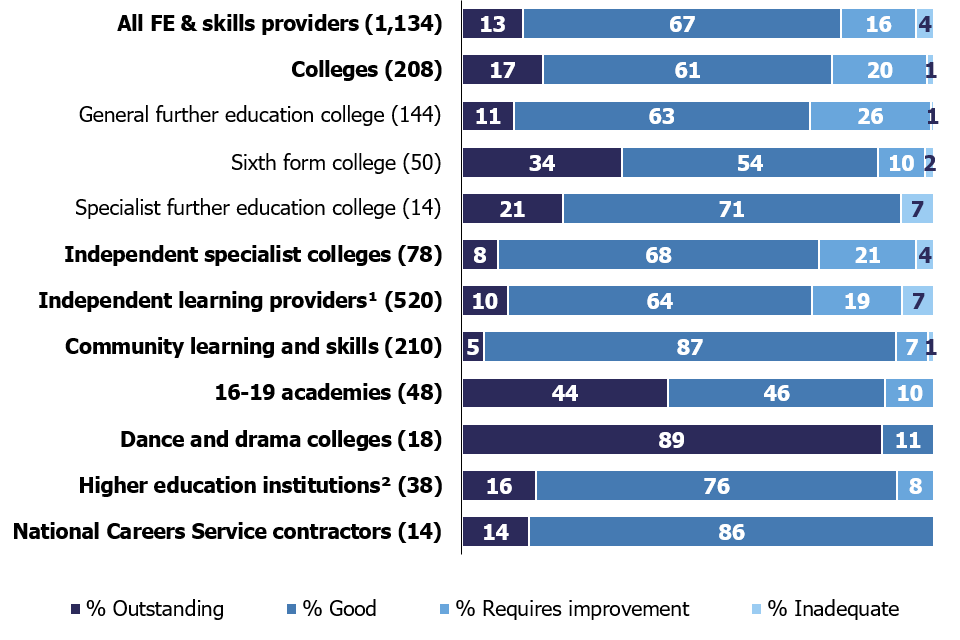
Number of providers in brackets.
Percentages are rounded and may not add to 100. When the number of providers is small, percentages should be treated with caution.
1. Includes employer providers.
2. Inspection of further education provision only, not provider as a whole.
Outcomes by provider group
General further education colleges
Almost half of the general further education colleges active on 31 August 2015 have now been through a merger.
In 2015, the government launched its review of post-16 education and training institutions across England. This led to a series of area reviews which, among other recommendations, resulted in a range of structural solutions such as mergers and colleges joining existing group structures.
On 31 August 2015, there were 214 general further education colleges recorded on Ofsted’s systems. Since that time, almost half of the colleges (96) have been through a merger. This has reduced the number of colleges we report on to 168 as at 29 February 2020. Although the number of colleges we report on has reduced by 21%, the original college sites continue to deliver provision and are still considered during the inspection of the new entity. A newly merged college does not carry forward any inspection grades from its predecessor colleges and will not have an overall effectiveness judgement until its first full inspection.
We had previously inspected all of the general further education colleges that merged. Most of the outstanding colleges did not merge (25 out of 34). Around half of the colleges judged either good, requires improvement or inadequate went through the merger process.
Figure 6: General further education college grade profile as at 31 August 2015 and 29 February 2020

1. Includes 3 new national colleges and one sixth-form college which converted to a general further education college. The overall effectiveness grades for these colleges are not included in this chart.
Since 2015, 90 of the general further education colleges that did not merge have been re-inspected and 70% were judged good or outstanding. The most recent inspection outcomes for the colleges that did not merge remained similar to the overall profile before the mergers, with 77% being judged good or outstanding.
As at 29 February 2020, we had inspected 23 of the 46 general further education colleges that were newly formed from a merger. Just under two thirds were judged good or outstanding (14), with the remaining colleges being judged requires improvement. Currently, this grade profile is lower than the original profile before the mergers, however, we have yet to inspect half of the colleges.
Overall, the proportion of general further education colleges that we had inspected and judged good or outstanding at their most recent inspection was 74% as at 29 February 2020. This is a decrease of 4 percentage points compared with 31 August 2019. The group that had the biggest impact on the proportion judged good or outstanding was the newly inspected colleges. Nine of the 18 general further education colleges inspected for the first time this year were judged requires improvement or inadequate. Seven of the 9 were merged colleges, including one judged inadequate.
Figure 7: Overall effectiveness of general further education colleges at their most recent inspection, over time
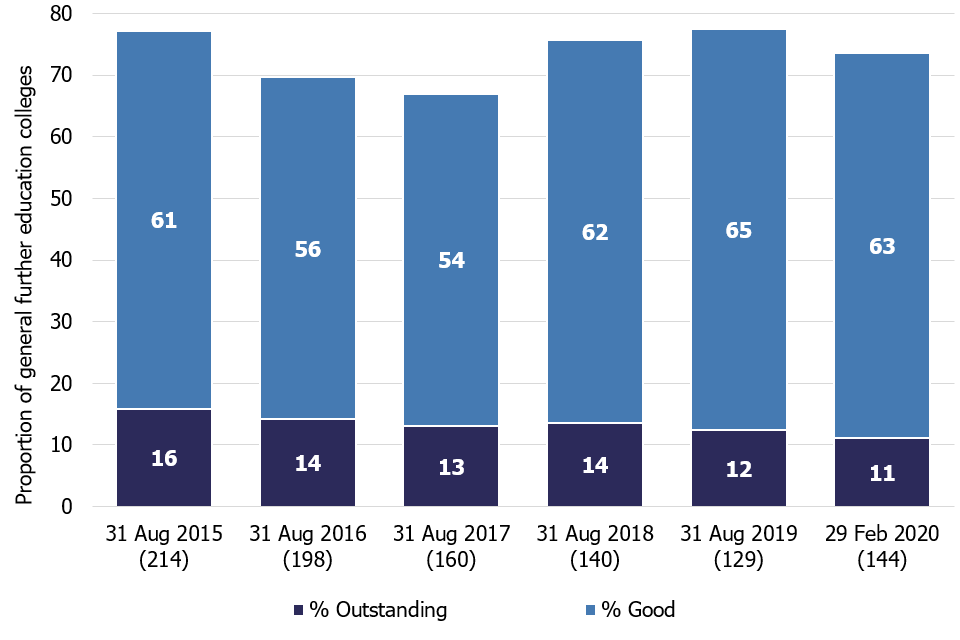
Number of providers in brackets.
Independent learning providers
The proportion of independent learning providers (including employer providers) judged good or outstanding declined for the fourth year.
Between 31 August 2017 and 31 August 2019, the number of independent learning providers (including employer providers) recorded on Ofsted’s systems rose by 143%, from 491 to 1,192. This was mainly as a result of the apprenticeship funding reforms introduced in April 2017. However, so far this reporting year, there has been a very small decrease of 11, to 1,181 providers as at 29 February 2020. This change was the result of 24 providers becoming publicly funded and starting to deliver education, training or apprenticeships, and 35 providers that were no longer funded and had stopped delivering.
Between 1 September 2019 and 29 February 2020, we inspected 74 independent learning providers and 11 employer providers. In total, there were 69 full inspections and 16 short inspections (including those that converted to full inspections).
Overall, 59% of providers were judged good, and none were judged outstanding. This is an increase of 17 percentage points compared with the proportion of providers judged good or outstanding in 2018/19. The increase can be attributed to the return of short inspections and a higher proportion of providers being judged good at their first inspection. In 2018/19, 39% of providers were judged good or outstanding at their first inspection. So far this reporting year, 53% of providers were judged good at their first inspection.
Figure 8: First full inspection outcome for independent learning providers (including employer providers), by reporting year

Number of inspections in brackets.
Although the proportion of independent learning providers (including employer providers) judged good or outstanding between 1 September 2019 and 29 February 2020 was higher than the previous reporting year, overall the proportion of providers judged good or outstanding at their most recent inspection declined by 1 percentage point; from 76% as at 31 August 2019 to 74% as at 29 February 2020. The decrease was due to a combination of factors:
- a much lower proportion of newly inspected providers were judged good or outstanding than the proportion as at 31 August 2019
- a larger number of newly inspected providers than previously inspected providers which left our data
- more providers declined from good or outstanding to requires improvement or inadequate, than improved
This is the fourth year there has been a decline in the proportion of independent learning providers (including employer providers) judged good or outstanding.
Figure 9: Proportion of independent learning providers (including employer providers) judged good or outstanding for overall effectiveness at their most recent inspection, over time
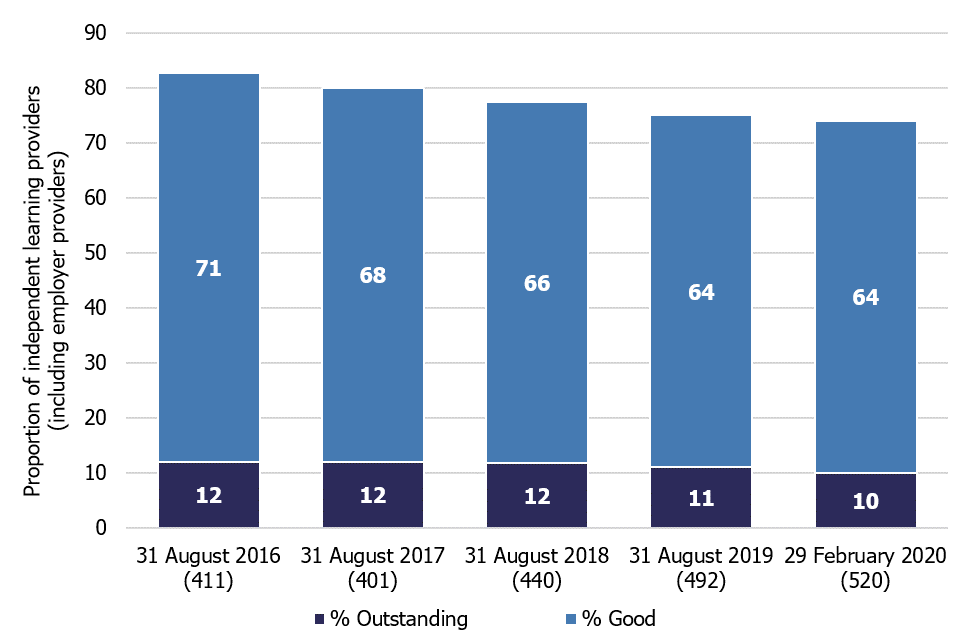
Number of providers in brackets.
Other further education and skills providers
Table 3: Summary of main findings for provider groups with between 5 and 25 inspections
| Provider type/group | No. of providers on 29 February 2020 | No. of inspections between 1 September 2019 and 29 February 2020 | Main findings |
|---|---|---|---|
| Community learning and skills providers | 213 | 9 full, 16 short (all remained good) | Two providers improved from requires improvement to good. One provider declined from good to requires improvement. The overall proportion of community learning and skills providers judged good or outstanding at their most recent inspection as at 29 February 2020, remained at 92%. |
| Sixth-form colleges | 51 | 7 full, 2 short (both remained good) | One sixth-form college improved from requires improvement to good. The one sixth form college inspected following a merger was judged inadequate. The overall proportion of sixth-form colleges judged good or outstanding at their most recent inspection as at 29 February 2020, remained at 88%. |
| 16 to 19 academies | 57 | 6 full, 3 short (2 remained good, one extended to a full inspection) | Three academies improved from requires improvement to good and one academy declined from good to requires improvement. Three academies were judged outstanding, including one inspected for the first time. The overall proportion of academies judged good or outstanding at their most recent inspection as at 29 February 2020 increased by 6 percentage points to 90% and the proportion judged outstanding increased by 4 percentage points to 44%. |
| Independent specialist colleges | 96 | 6 full, 2 short (both remained good) | One previously outstanding independent specialist college remained outstanding. Four independent specialist colleges were judged good including 2 that improved from requires improvement. One independent specialist college remained requires improvement. The overall proportion of independent specialist colleges judged good or outstanding at their most recent inspection as at 29 February 2020, increased by 5 percentage points to 76%. |
Prisons and young offender institutions
Of the 8 prisons and young offender institutions that were previously judged good, 5 declined to requires improvement and one declined to inadequate.
On 29 February 2020, there were 114 prisons and young offender institutions. All of these had been inspected.
Ofsted contributed to 20 prison and young offender institution inspections where the reports were published between 1 September 2019 and 29 February 2020. All of the prisons and young offender institutions had previously been inspected. Most of the prisons and young offender institutions previously judged good declined at inspection and most of those that previously required improvement remained at that grade.
Table 4: The overall effectiveness[footnote 1] of education, skills and work in prisons and young offender institutions published between 1 September 2019 and 29 February 2020, by previous overall effectiveness grade
| Previous overall effectiveness | Total number of inspections | Outstanding | Good | Requires improvement | Inadequate |
|---|---|---|---|---|---|
| Outstanding | 1 | 0 | 1 | 0 | 0 |
| Good | 8 | 0 | 2 | 5 | 1 |
| Requires improvement | 10 | 0 | 1 | 7 | 2 |
| Inadequate | 1 | 0 | 0 | 0 | 1 |
| Total | 20 | 0 | 4 | 12 | 4 |
Number of inspections
Overall, more prisons and young offender institutions declined to be less than good than improved to good. Therefore, the in-year inspection outcomes led to a decline in the proportion of prisons and young offender institutions judged good or outstanding at their most recent inspection by 4 percentage points, to 46%. The proportion of prisons and young offender institutions judged inadequate increased to 16%, the highest it has been in the last 5 years.
Figure 10: Overall effectiveness of education, skills and work in prisons and young offender institutions at their most recent inspection, over time

Inspections published by 29 February 2020.
Number of prisons and young offender institutions in brackets.
Percentages are rounded and may not add to 100.
In 2019, we started to carry out prison monitoring visits to contribute towards Her Majesty’s Inspectorate of Prisons’ independent reviews of progress. The monitoring visits judged the prison’s progress against themes identified from the key concerns at the previous inspection.
Since 1 September 2019, we carried out 6 prison monitoring visits. All prisons were judged to have made insufficient progress in at least one theme and 2 prisons were judged to be making insufficient progress across all 3 themes.
Revisions to previous release
In-year statistics
Alongside these official statistics, we have published a revised provider-level dataset, which includes inspections carried out between 1 September 2018 and 31 August 2019. This is due to us publishing an additional monitoring visit report and a full inspection report, and withdrawing one monitoring visit report, since the previous iteration of these statistics. These changes do not affect the overall messages of the main findings or the tables and charts as previously reported.
We publish revisions to data in this publication in line with our revisions policy for official statistics.
Notes
The quality report for these official statistics contains an explanation of the methodology used and the relevant inspection frameworks, along with other useful information.
Glossary
Definitions of terms are within the statistical glossary
Further information
Contact for comments or feedback
If you have any comments or feedback on this publication, you should contact Richard Jones on 03000 130 608 or [email protected].
Acknowledgements
Thanks to the following for their contribution to this statistical release: Angela Serjeant, Simon Gilson, John Hadler, Emily Green and Kyle Drury.
Instructions for printing and saving
Depending on which browser you use, such as Internet Explorer or Google Chrome, and the type of device you use, such as an iPhone or laptop, these instructions may vary.
You will find your print and save options in your browser’s menu. You may also have other options available on your device. Tablets and mobile device instructions will be specific to the make and model of the device.
How to search the guidance
Click on Ctrl + F on a Windows laptop or Command + F on a Mac
This will open a search box in the top right-hand corner of the page. Type the word you are looking for in the search bar and press enter.
Your browser will highlight the word, usually in yellow, wherever it appears on the page. Press enter to move to the next place it appears.
How to print a copy of the guidance
Click on Ctrl + P on a Windows laptop or Command + P on a Mac
You can also choose to save as a PDF.
-
Previously known as ‘learning and skills and work activities’. ↩

